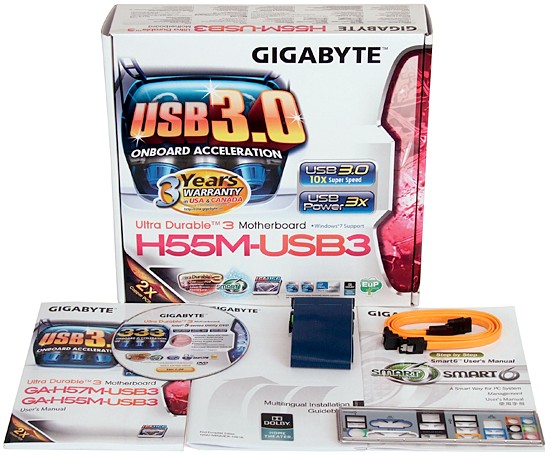Budget Computing: Nine H55 And H57 Motherboards Compared
Gigabyte H55M-USB3
Gigabyte is the second company to take our “features for the money” concept well into the features category by providing a USB 3.0-compatible motherboard. Yet, its H55M-USB3 pushes a little further towards the premium market by also providing both HDMI and DisplayPort interfaces. A total of four onboard video outputs are configurable across two display devices.
Other handy (but less spectacular) features include a second x16-length slot, but further examination showed that slot is limited to only one 2.5Gb/s pathway. The primary x16 slot has 32 times the bandwidth, but installing a graphics card there prevents the integrated graphics ports from working.
Windows XP users will appreciate the easier installation of AHCI drivers via the H55M-USB3’s floppy connector, while system integrators will have just as much appreciation for the board’s ability to support legacy serial and Ultra ATA devices. Missing, however, is the parallel port so often required by system integrators to support legacy software security dongles.
As the H55M-USB3’s primary market, high-end media center PC builders won’t likely notice the legacy hardware and might instead focus on the motherboard’s true PCIe x16 and PCI slot positions, which perfectly match the card riser locations of many low-profile cases. Support for up to four memory modules and seven internal drives is consistent with that market, as is RAID 0 and 1 support through the GSATA2 Serial ATA/Ultra ATA controller. However, users who require the additional performance or configurability of Intel’s software-based RAID modes will have to step up to the nearly identical H57 model with a similar name.
BIOS Features
Gigabyte’s H55M-USB3 supports a broad range of overclocking and underclocking options to meet the needs of both silent PC and compact performance enthusiasts. Controls are divided across several submenus of the M.I.T.'s many menus, where current settings are also displayed.


Underclockers can minimize voltage needs by reducing the multiplier or base clock, while overclockers can shoot for the moon on base clock with the aid of drive strength and clock skew controls.
Get Tom's Hardware's best news and in-depth reviews, straight to your inbox.


Setting DRAM Timing Selectable to Quick allows Channel B timings to be set simultaneously with Channel A, simplifying memory-performance configuration.
Sky-high upper voltage limits of 1.90 and 2.60V for the CPU core and RAM should satisfy the needs of nearly any overclocker, but Gigabyte also plays to the silent PC crowd with lower CPU and DRAM limits of 0.50 and 1.30V.


The H55M-USB3 stores up to eight BIOS configurations as user profiles, and can also export these to a drive. Gigabyte also automatically stores up to four additional configurations to assist forgetful tuners.
Accessories
The wide variety of internal interfaces is not reflected in the H55M-USB3 installation kit, as only one legacy Ultra ATA and two SATA cables are included. A Dolby Home Theater sticker points to the extended feature pack Gigabyte purchased for Realtek’s ALC889 codec, enabling advanced options such as Dolby Digital Live.




